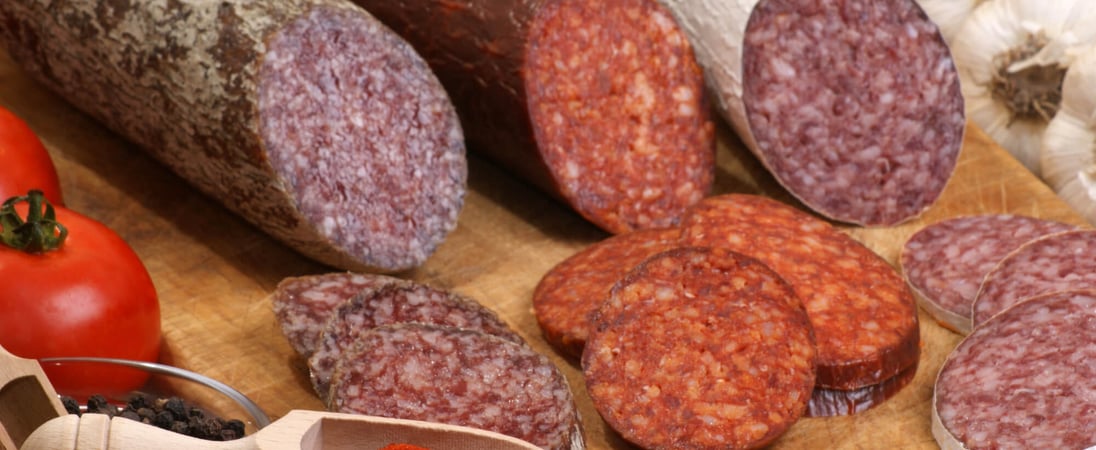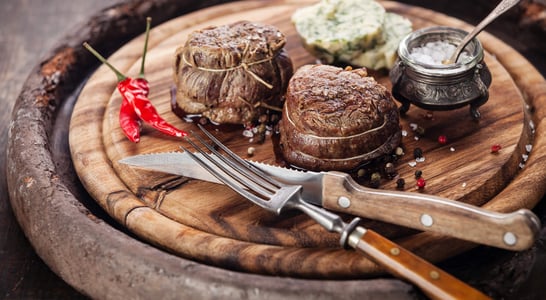
National Salami Day
Savory, spiced, and sliced thin, this protein-packed snack is perfect for picnics, parties, and snacking on-the-go.
Salami is cured, fermented and air-dried sausage, popular in Italy and the mediterranean, as well as around the world.
This meat is convenient due to its relatively long shelf life, and it can be used in a variety of delicious recipes. Plus, it now has a special day just to call its own. It’s National Salami Day!
How to Celebrate National Salami Day
Enjoy Salami with Friends, Family and Coworkers
National Salami Day encourages people all over the globe to explore the world of salami by trying new and adventurous types of salami, and enjoying salami with friends at salami-themed parties.
Instead of cooking dinner, create a lovely charcuterie board that includes salami and other cold meats served with cheeses and fruits.
Or take a deli platter filled with salami, cheeses and veggies to work to encourage the whole office to get involved with celebrating the fun that comes along with National Salami Day.
Take a Picnic with Salami
Salami is actually an ideal picnic food because it does not require refrigeration and can be packed into a basket with bread, cheese, fruit and other delicious items that can be spread out on a picnic blanket to enjoy with friends.
Plan a Trip To Italy to Enjoy Salami
Considered to be an important staple in food throughout the country, National Salami Day might just be the perfect excuse to take a trip to the beautiful Italy. Here, it’s easy to find lengths of dry cured salami simply hanging in butchers or grocery stores.
Slice it thick or thin, depending on the style of meat, and enjoy it on a fresh baguette (which European bakeries are famous for) topped with a hunk of fresh cheese. Of course, don’t forget to enjoy a few olives and a glass of lovely red wine with it as well. Italy is absolutely delicious!
While in Italy, it would be a shame not to visit the Salami Museum in Parma. Located in the lovely cellars of the Felino Castle, this museum boasts the history of salami using documents dating back as far as 1436. It also houses various instruments related to butchery, as well as other artifacts and showrooms.
Or, pop over the charcuterie museum, called the Museo della Salumeria. (It’s located in a castle, Castelnuovo Rangone, in Modena, Italy, which is actually less than an hour’s drive from Parma!) It offers an insider’s view of the production facilities as well as displays of machinery, herbs, spices and other salami related items.
Make Some Salami Recipes
While this might be a surprise, some big fans of salami believe that it is as versatile as bacon when used in cooking!
It can certainly do more than simply be sliced and slapped on a piece of bread with cheese. Try out these ideas for cooking with salami to add some unique flavors and interesting takes on culinary adventures:
- Salami with Fried or Scrambled Eggs. Whether using it as a side to go along with a fried egg, adding it chopped up into an omelette, or making it into a delicious hash, salami makes a great meat to be paired with eggs–at breakfast or any time of the day.
- Salami with a Bowl of Pasta. A new version of Pasta Carbonara (pasta with bacon), chop up some salami finely and add to a red sauce to place over pasta.
- Salami on a Grilled Cheese Sandwich. It’s true that today’s grilled cheese sandwiches aren’t just for kids anymore! All kinds of different gourmet options can be created for this delicious and easy favorite sandwich–including a grilled cheese with salami slices.
- Salami in Soups. Salami is a great meat to add to soups that are thrown together and made with whatever is on hand in the kitchen. Try salami in a bean soup or vegetable soup. Or channel that inner Italian and throw some salami into a minestrone soup recipe.
History of National Salami Day
Salami has a relatively unknown history as its creation cannot easily be traced to a particular time.
However, some researchers believe that the ancient Romans would eat salami as a part of a larger food group that used salt as a preservative which is probably where it got its name, since ‘salare’ is Italian for salt.
Most people consider salami to be an Italian food–and even the word is Italian! The English language simply used the pluralized form of the Italian word ‘salame’ to indicate the cased meat but, in English, ‘salami’ is singular.
As an air-cured pork meat, salami is a cased meat that was originally wrapped in a natural skin made of other parts of the pig. Sometimes it is also made from beef, wild boar, goose, venison or even duck for unique variations.
Meat for salami comes from different parts of the pig (or other animal), and should include a mixture of lean meat as well as fat in order to get the flavor just right.
That’s why the look of the inside of the meat has a marbled looking texture. Although ‘lean salami’ has been popularized for its health benefits, most artisanal salami makers would say that the flavor is not as good.
To make salami, the meat is ground up to a fine texture and then flavored by adding spices or herbs. Some of the most popular flavorings include garlic, white pepper, vinegar or even wine. (Salami’s flavor is not as strong as its popular pizza-topping cousin, pepperoni.)
Once stuffed into the casing, salami is usually aged in a fermentation and drying process that lasts between one and three months–or sometimes longer, even up to several years.
Today, Europe is a huge producer of salami. In fact, between Germany, Italy, France, Hungary and the other countries that produce it, several hundred million pounds of salami are produced and eaten each year.
National Salami Day got its start in 2006. Started in Henrico, Virginia by a group known as the Salami Appreciation Society (SAS), the idea was that the salami is a meat that is far too often overlooked and it needed to be given its day in the sun.
The official National Salami Day website offers fun tidbits and ideas for celebrating.
National Salami Day FAQs
What are some little-known historical origins of salami?
Salami dates back to ancient Rome, where it was a method to preserve meat.
Romans seasoned pork with salt and spices, then air-dried it. This technique spread across Europe, evolving into regional varieties like Italian Genoa and Hungarian salami.
The word “salami” comes from the Latin “salumen,” meaning salted meat. Its popularity grew during the Middle Ages as a portable, long-lasting food for travelers and soldiers.
Are there any unique cultural celebrations of Salami Day outside the U.S.?
In Hungary, salami is celebrated during festivals like the Budapest Salami Festival, featuring tastings and competitions.
In Italy, some towns host “sagre,” or food fairs, dedicated to salami, often paired with local wines.
In Germany, salami is a staple during Oktoberfest, served alongside pretzels and beer. These celebrations highlight salami’s versatility and cultural significance across Europe.
What are some quirky myths or misconceptions about salami?
A common myth is that salami is unhealthy due to its fat content.
However, traditional salami is rich in protein and contains beneficial fats. Another misconception is that all salami tastes the same; in reality, flavors vary widely based on spices, curing methods, and regional recipes.
Some also believe salami is raw, but the curing process makes it safe to eat without cooking.
What are some unusual ways people celebrate Salami Day?
Some enthusiasts host salami-themed charcuterie board competitions, showcasing creative arrangements.
Others participate in salami-making workshops to learn traditional techniques.
In Australia, a few communities organize “salami throw” contests, where participants toss salami logs for distance. These quirky activities add a fun twist to the holiday.
What are some lesser-known types of salami from around the world?
Beyond the popular Italian and Hungarian varieties, there’s Spanish “salchichón,” made with paprika and garlic. French “saucisson sec” features a distinct nutty flavor from longer aging.
Turkish “sucuk” is a spicy, fermented sausage often grilled. South African “droëwors” is a dried sausage similar to salami but made with game meat like venison.
How has salami influenced pop culture or media?
Salami has appeared in films like “The Godfather,” where it symbolizes Italian heritage.
In cartoons, characters often use salami as a comedic prop, such as in “Tom and Jerry.”
Salami also inspired the phrase “cut the salami,” meaning to divide something unfairly. Its cultural impact extends beyond food, making it a recognizable symbol in entertainment.
What are some fun, lesser-known facts about salami production?
Salami production involves natural fermentation, where beneficial bacteria break down sugars, creating its tangy flavor. Some producers use wine or vinegar to enhance this process.
The curing time can range from weeks to months, depending on the type. Interestingly, mold on the casing is often intentional, adding flavor and protecting the meat.
What are some unique pairings for salami beyond cheese and crackers?
Salami pairs well with fruits like melon or figs, balancing its saltiness with sweetness.
In Spain, it’s often served with olives and almonds. Some chefs use salami in desserts, such as chocolate-covered salami slices. In cocktails, salami-infused vodka has gained popularity for its bold, savory flavor.
What are some amusing historical anecdotes involving salami?
During World War II, American soldiers nicknamed Italian salami “Dago Red” due to its red casing.
In the 1950s, a salami shortage in New York led to a black market, with prices skyrocketing. In 2019, a stolen salami truck in Italy made headlines, highlighting the meat’s cultural value.
How has salami been used in traditional medicine or folklore?
In some European folklore, salami was believed to ward off evil spirits when hung in doorways.
In traditional medicine, it was thought to boost energy and strength due to its high protein content. Some cultures used salami as a remedy for anemia, though this has no scientific basis.
See what else is happening…
There’s always more going on every month at Days Of The Year. Here are our favorites this month!
Also on ...
View all holidaysNational Buy a Book Day
Whether you have three shelves of books TBR or haven’t cracked a spine in years, go ahead and buy a book to improve your mind. Consider donating old books for others.
National Beer Lovers Day
Beer lovers, it’s your day! Try a new beer, visit a brewery or taphouse, or gather friends together to try a wide selection of beers, from lagers to IPAs and more.
Superhuman Day
Learn more about the Superhumans of the Paralympic Games and beyond through the documentary “We’re the Superhumans”, and support the Paralympics.
Neither Snow Nor Rain Day
With unwavering dedication, postal workers brave all elements, ensuring vital connections between people. Rain or shine, their commitment shines brightly.
We think you may also like...
National Quiche Lorraine Day
A shortcrust pastry, bacon, eggs, cream, milk, cheese, and a little time in the oven; that’s all it takes to make the delicious and fancy-sounding Quiche Lorraine.
National Filet Mignon Day
The words “filet mignon” call to mind rich, succulent, melt-in-your mouth flavor. Treat yourself to a nice steak dinner, or try cooking it at home.
National Double Cheeseburger Day
Juicy, grilled patties layered with melted cheese and savory toppings, creating a satisfying blend of flavors that's a favorite among many.
Cornish Pasty Week
If you're looking for a portable, delicious snack, try these hand-held wonders from across the pond. Perfect for a hearty lunch on the go!








